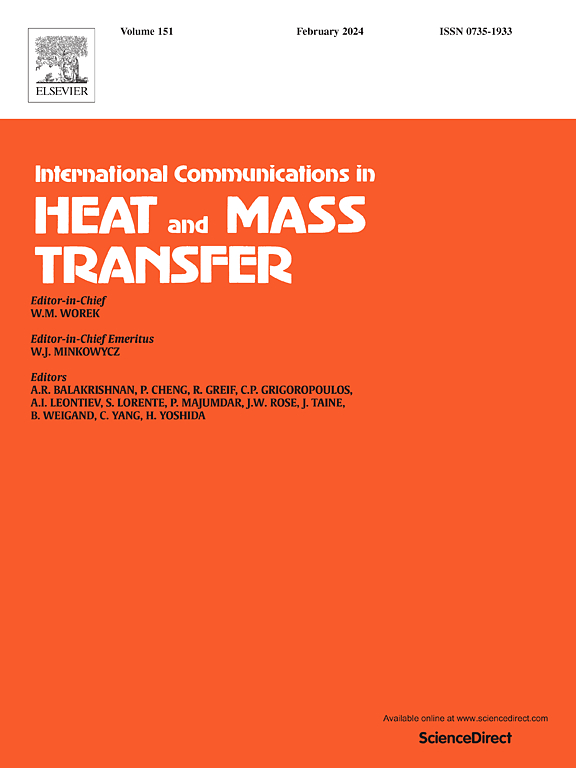Visualization and experimental investigation of two-phase flow in S-shaped microchannel heat sink
IF 6.4
2区 工程技术
Q1 MECHANICS
International Communications in Heat and Mass Transfer
Pub Date : 2025-03-23
DOI:10.1016/j.icheatmasstransfer.2025.108883
引用次数: 0
Abstract
An experimental visualization was used to explore the flow pattern and bubble behavior in S-shaped microchannel heat sink. The micro-channel and micro-fin width is 0.5 mm and 0.35 mm, respectively, and the micro-fin height is 0.29 mm. The heat flux over 180 W/cm2 can be dissipated by a relatively low inlet flow rate of 15 mL/min using HFE7100 as the coolant. PDMS was used as the visual test assembly and the bubble behavior was observed by a high-speed camera. Results show that the two-phase flow patterns in the heat sink are as follows: bubbly flow, slug flow, churn flow, annular flow and local irregular bubbles by extrusion. Small bubbles re-perform the bubble behavior in the S-shaped microchannel: bubble formation - bubble growth- bubble deformation - bubble assemblage - bubble breakage - bubble growth. The main reasons for the instability of the two-phase flow are the flow mal-distribution, the flow pattern transition, the bubble behavior and periodic local drying. Moreover, the heat transfer performance was investigated and results show that the S-shaped microchannel heat sink with 3 inlets and 4 outlets has the maximum effective heat transfer coefficient of 1.1 × 105 W/m2⋅K and two-phase heat transfer coefficient of 9.9 × 105 W/m2⋅K when the heat flux is 61.91 W/cm2 with a pressure drop of 18.3 kPa.
求助全文
约1分钟内获得全文
求助全文
来源期刊
CiteScore
11.00
自引率
10.00%
发文量
648
审稿时长
32 days
期刊介绍:
International Communications in Heat and Mass Transfer serves as a world forum for the rapid dissemination of new ideas, new measurement techniques, preliminary findings of ongoing investigations, discussions, and criticisms in the field of heat and mass transfer. Two types of manuscript will be considered for publication: communications (short reports of new work or discussions of work which has already been published) and summaries (abstracts of reports, theses or manuscripts which are too long for publication in full). Together with its companion publication, International Journal of Heat and Mass Transfer, with which it shares the same Board of Editors, this journal is read by research workers and engineers throughout the world.

 求助内容:
求助内容: 应助结果提醒方式:
应助结果提醒方式:


